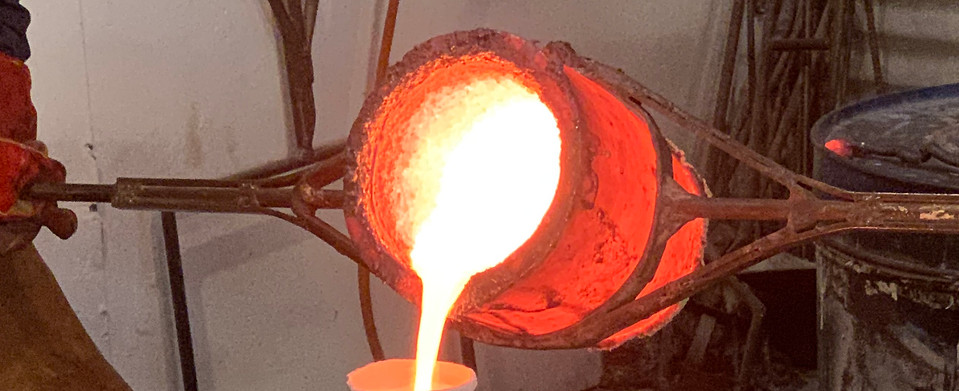

At the start of each sculpture's creation, an armature of aluminium wire is built. This skeleton gives the sculpture more strength and flexibility. Once the sculpture is created in water-based clay, it must undergo many labour-intensive processes. I have been very fortunate to have located a highly skilled professional at a Foundry in England.

At the start of each sculpture's creation, an armature of aluminium wire is built. This skeleton gives the sculpture more strength and flexibility. Once the sculpture is created in water-based clay, it must undergo many labour-intensive processes. I have been very fortunate to have located a highly skilled professional at the Lockbund Foundry in England.
The first step at the foundry is Mould Making.
Once the clay sculpture is leather hard but not dry, a silicon rubber mixture is painted in several layers, capturing every tiny detail. This rubber mould is an exact negative of the clay sculpture.
After the layers are complete, a final stiff fibreglass jacket is applied to the soft rubber mould. All is held together by screws that are placed in the outer coat of the mould, and the mould can be opened up like a clam and the clay sculpture released and discarded.
Now follows the Wax Pouring of the sculpture. Liquid wax is poured into the mould in several layers at different temperatures. Once the ‘wax sculpture’ is cooled, it will be removed from the mould. It will be pieced back together, and all imperfections, such as air bubbles or seam lines, will be removed. At this point, I can look at the sculpture and make last-minute corrections.
This and all subsequent processes must be repeated every time a new sculpture is made from an existing edition (mould).
Spruing attaches solid wax rods and a larger wax funnel to a wax sculpture. These spruces allow the molten bronze to move freely into the mould and release gases.
The sprued wax is now coated with fine ceramic fluid and grit several times. This new shell is robust and can resist the heat of the molten bronze.
After the ceramic shell has dried, it is fired upside down in a kiln at temperatures up to 1000 degrees Celsius to harden it and allow the wax to melt. This process is also known as the ‘Lost Wax Procedure’.
Pouring of the Bronze.
This highly detailed ceramic shell can now be filled with molten bronze at 1200 degrees Celsius. Placed in a large crate full of sand with the wax funnel facing upwards, the shell is now filled with liquid bronze.
When the ceramic shell and bronze have cooled, the ceramic shell is broken apart and hammered away, and the sprues are cut off.
A large sculpture is likely to have been cast in several pieces, which must be welded together to form the original. More miniature sculptures can be cast in one piece.
This highly skilled process is called Chasing. An excellent-quality sculpture does not show that it has been chased but looks as if it was cast in one piece.
The last step is the Patina. The sculpture is heated with a blowtorch, and, like applying paint to a canvas, chemicals (oxides and nitrates) are used with a brush to the shiny bronze to create different colourations and shades.
Sculpture Commissions
It is an excellent way of working with a client and creating a tailor-made, unique piece of art.
Please contact me via the CONTACT PAGE or email me directly to discuss your ideas.
Previous Commissions / Collections
Mayo Clinic, London
Irish Embassy London
Irish Embassy Washington
Various private commissions
